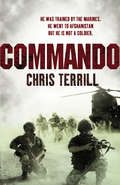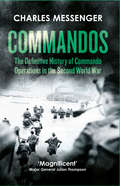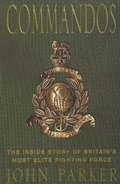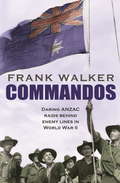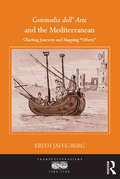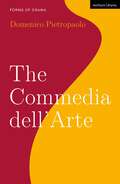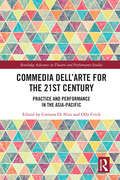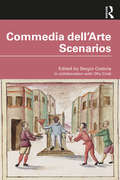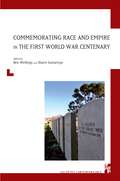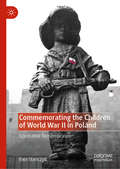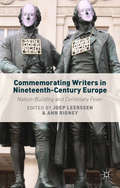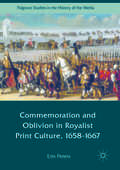- Table View
- List View
Commando
by Chris TerrillChris Terrill is a man in search of his limit. He's 55 years old. He is not a soldier. He is being trained by the Royal Marines and he is going to Afghanistan. The only difference is that instead of a gun, Chris will be holding a camera and filming the whole ordeal for a major TV series.The Royal Marines Commando training base in Lympstone Devon, has a famous motto: '99.9% need not apply'. Of those who start training, after a very tough selection process, nearly 50% fail to make it through the most gruelling physical tests of any armed forces in the world in an eight month training regime. The elite who do eventually pass out are generally eighteen years old and at the peak of physical condition. But Chris Terrill is the exception: this book will tell of his heroic struggle to become the oldest man to win the coveted Royal Marines Commando Green Beret and enter the record books.And after six months of hell, what next? Chris will follow the raw recruits on a tour to Southern Afghanistan. He will tell the story in book and film of the fears and hopes of the youngsters as they are plunged into one of the planet's most dangerous wars in the outlaw mountain terrain of Helmand Province. He will tell of ferocious battles against the Taliban, of firefights, of jaw-dropping heroism, British sang froid and humour and tragedy as causalities are suffered -- all from the unique perspective of a civilian who has achieved the ultimate accolade: to be accepted as an honorary Royal Marines Commando. Commando is a brilliant account of modern war on the front line.
Commando Medic: Doc Harden VC
by Stephen J. SnellingEric Harden was the only British army medic to be awarded the nation’s highest honour for battlefield bravery during the Second World War and remains the only rank and file member of the Royal Army Medical Corps to be recognised by the award of the Victoria Cross. As a pre-war member of the St John Ambulance, he saw service during the 1940-41 Blitz and later volunteered for the Commandos, under-going the same rigorous training as the fighting men before being attached to 45 Royal Marine Commando. He landed with his unit on D-Day and was involved in some of the fiercest fighting of the Normandy campaign. During a bitter battle on the Dutch-German border, Harden, known throughout his unit as Doc, was killed saving the lives of wounded men trapped in no-man’s land. Commenting on the posthumous award in a speech to the House of Commons, the Secretary of State for War, the Rt Hon James Grigg was sufficiently moved by his selfless actions to say: “I do not remember ever reading anything more heroic.”
Commandos: The Definitive History Of Commando Operations In The Second World War
by Charles MessengerThe definitive and thrilling history of those who wore the famous green beret.
Commandos: The Inside Story Of A Force For The Future
by John ParkerThe Commandos were Britain's first-ever special forces, formed in 1940 using volunteers from all three services. After the war, Commando units of the Royal Marines engaged in virtually every military scenario involving British troops from 1945 to the present day. They became the elite of the British 'ready-to-go' forces, capable of deploying at a moment's notice to any trouble spot in the world. In this latest book in John Parker's acclaimed series on British military activity, dramatically recalled in their own words by men who were there, he recounts the major events in the 60-year history of British Commando forces.
Commandos: Heroic and Deadly ANZAC Raids in World War II
by Frank WalkerAmazing revelations and extraordinary exploits of Australia's elite secret warriors.There was something unique about Australians and New Zealanders in war that prompted World War II Allied commanders to turn to ANZAC soldiers, sailors and airmen to carry out the most dangerous and virtually impossible missions behind enemy lines.Paddling canoes 4,000 kilometres to attack enemy ships in Singapore; lightning raids on Rommel's forces in the deserts of North Africa. Flying bombers at tree-top level deep into Nazi Germany to destroy vital targets; rescuing sultans and future US presidents from under the noses of the Japanese and playing crucial roles in the greatest commando raid of the war at St Nazaire - the Aussies and Kiwis were there.The special forces showed incredible bravery in the face of overwhelming odds. They were determined to complete their missions. Often alone and far behind enemy lines,they demonstrated resourcefulness, spirit and a humanity that inspired others to follow them.Frank Walker, author of bestselling books on the Vietnam War and the British atomic tests in Australia, brings to life the amazing exploits and extraordinary stories of this select band of heroes..
Commedia dell' Arte and the Mediterranean: Charting Journeys and Mapping 'Others' (Transculturalisms, 1400-1700)
by Erith Jaffe-BergDrawing on published collections and also manuscripts from Mantuan archives, Commedia dell' arte and the Mediterranean locates commedia dell' arte as a performance form reflective of its cultural crucible in the Mediterranean. The study provides a broad perspective on commedia dell’ arte as an expression of the various cultural, gender and language communities in Italy during the early-modern period, and explores the ways in which the art form offers a platform for reflection on power and cultural exchange. While highlighting the prevalence of Mediterranean crossings in the scenarios of commedia dell' arte, this book examines the way in which actors embodied characters from across the wider Mediterranean region. The presence of Mediterranean minority groups such as Arabs, Armenians, Jews and Turks within commedia dell' arte is marked on stage and 'backstage' where they were collaborators in the creative process. In addition, gendered performances by the first female actors participated in 'staging' the Mediterranean by using the female body as a canvas for cartographical imaginings. By focusing attention on the various communities involved in the making of theatre, a central preoccupation of the book is to question the dynamics of 'exchange' as it materialized within a spectrum inclusive of both cultural collaboration but also of taxation and coercion.
Commedia dell' Arte and the Mediterranean: Charting Journeys and Mapping 'Others' (Transculturalisms, 1400-1700)
by Erith Jaffe-BergDrawing on published collections and also manuscripts from Mantuan archives, Commedia dell' arte and the Mediterranean locates commedia dell' arte as a performance form reflective of its cultural crucible in the Mediterranean. The study provides a broad perspective on commedia dell’ arte as an expression of the various cultural, gender and language communities in Italy during the early-modern period, and explores the ways in which the art form offers a platform for reflection on power and cultural exchange. While highlighting the prevalence of Mediterranean crossings in the scenarios of commedia dell' arte, this book examines the way in which actors embodied characters from across the wider Mediterranean region. The presence of Mediterranean minority groups such as Arabs, Armenians, Jews and Turks within commedia dell' arte is marked on stage and 'backstage' where they were collaborators in the creative process. In addition, gendered performances by the first female actors participated in 'staging' the Mediterranean by using the female body as a canvas for cartographical imaginings. By focusing attention on the various communities involved in the making of theatre, a central preoccupation of the book is to question the dynamics of 'exchange' as it materialized within a spectrum inclusive of both cultural collaboration but also of taxation and coercion.
The Commedia dell’Arte (Forms of Drama)
by Domenico PietropaoloWhat were the origins of commedia dell'arte and how did it evolve as a dramatic form over time and as it spread from Italy? How did its relationship to the ruling ideology of the day change during the Enlightenment? What is its legacy today? These are just some of the questions addressed in this authoritative overview of the dramatic, ideological and aesthetic form of commedia dell'arte. The book's 3 sections examine the changing role of performers and playwrights, improvisatory scenarios and scripted performance, and its function as a vehicle for social criticism, to offer readers a clear understanding of commedia dell'arte's evolution in Renaissance Italy and beyond. This study throws new light on the role of women performers; on the changing ideological discourse of commedia dell'arte, which included social reform and, later, conservatism as well as the alienation of ethnic minorities in complicity with its audience; and on its later adaptation into hybrid forms including grotesque dance and the giullarata typified by the work of Dario Fo.
The Commedia dell’Arte (Forms of Drama)
by Domenico PietropaoloWhat were the origins of commedia dell'arte and how did it evolve as a dramatic form over time and as it spread from Italy? How did its relationship to the ruling ideology of the day change during the Enlightenment? What is its legacy today? These are just some of the questions addressed in this authoritative overview of the dramatic, ideological and aesthetic form of commedia dell'arte. The book's 3 sections examine the changing role of performers and playwrights, improvisatory scenarios and scripted performance, and its function as a vehicle for social criticism, to offer readers a clear understanding of commedia dell'arte's evolution in Renaissance Italy and beyond. This study throws new light on the role of women performers; on the changing ideological discourse of commedia dell'arte, which included social reform and, later, conservatism as well as the alienation of ethnic minorities in complicity with its audience; and on its later adaptation into hybrid forms including grotesque dance and the giullarata typified by the work of Dario Fo.
Commedia dell’Arte for the 21st Century: Practice and Performance in the Asia-Pacific (Routledge Advances in Theatre & Performance Studies)
by Corinna Di Niro Olly CrickThis book discusses the evolution of Commedia dell’Arte in the Asia-Pacific where through the process of reinvention and recreation it has emerged as a variety of hybrids and praxes, all in some ways faithful to the recreated European genre. The contributors in this collection chart their own training in the field and document their strategies for engaging with this form of theatre. In doing so, this book examines the current thoughts, ideas, and perceptions of Commedia – a long-standing theatre genre, originating in a European-based collision between neo-classical drama and oral tradition. The contributing artists, directors, teachers, scholars and theatre-makers give insight into working styles, performance ideas, craft techniques and ways to engage an audience for whom Commedia is not part of their day-to-day culture. The volume presents case studies by current practitioners, some who have trained under known Commedia ‘masters’ (e.g. Lecoq, Boso, Mazzone-Clementi and Fava) and have returned to their country of origin where they have developed their performance and teaching praxis, and others (e.g. travelling from Europe to Japan, Thailand, Singapore and China) who have discovered access points to share or teach Commedia in places where it was previously not known. This book will be of great interest to students and scholars in Performing arts, Italian studies, and History as well as practitioners in Commedia dell’Arte.
Commedia dell’Arte for the 21st Century: Practice and Performance in the Asia-Pacific (Routledge Advances in Theatre & Performance Studies)
by Corinna Di Niro Olly CrickThis book discusses the evolution of Commedia dell’Arte in the Asia-Pacific where through the process of reinvention and recreation it has emerged as a variety of hybrids and praxes, all in some ways faithful to the recreated European genre. The contributors in this collection chart their own training in the field and document their strategies for engaging with this form of theatre. In doing so, this book examines the current thoughts, ideas, and perceptions of Commedia – a long-standing theatre genre, originating in a European-based collision between neo-classical drama and oral tradition. The contributing artists, directors, teachers, scholars and theatre-makers give insight into working styles, performance ideas, craft techniques and ways to engage an audience for whom Commedia is not part of their day-to-day culture. The volume presents case studies by current practitioners, some who have trained under known Commedia ‘masters’ (e.g. Lecoq, Boso, Mazzone-Clementi and Fava) and have returned to their country of origin where they have developed their performance and teaching praxis, and others (e.g. travelling from Europe to Japan, Thailand, Singapore and China) who have discovered access points to share or teach Commedia in places where it was previously not known. This book will be of great interest to students and scholars in Performing arts, Italian studies, and History as well as practitioners in Commedia dell’Arte.
Commedia dell'Arte Scenarios
by Sergio CostolaCommedia dell'Arte Scenarios gathers together a collection of scenarios from some of the most important Commedia dell'Arte manuscripts, many of which have never been published in English before. Each script is accompanied by an editorial commentary that sets out its historical context and the backstory of its composition and dramaturgical strategies, as well as scene summaries, and character and properties lists. These supplementary materials not only create a comprehensive picture of each script’s performance methods but also offer a blueprint for readers looking to perform the scenarios as part of their own study or professional practice. This collection offers scholars, performers and students a wealth of original performance texts that brig to life one of the most foundational performance genres in world theatre.
Commedia dell'Arte Scenarios
by Sergio Costola Olly CrickCommedia dell'Arte Scenarios gathers together a collection of scenarios from some of the most important Commedia dell'Arte manuscripts, many of which have never been published in English before. Each script is accompanied by an editorial commentary that sets out its historical context and the backstory of its composition and dramaturgical strategies, as well as scene summaries, and character and properties lists. These supplementary materials not only create a comprehensive picture of each script’s performance methods but also offer a blueprint for readers looking to perform the scenarios as part of their own study or professional practice. This collection offers scholars, performers and students a wealth of original performance texts that brig to life one of the most foundational performance genres in world theatre.
Commemorating Power in Early Medieval Saxony: Writing and Rewriting the Past at Gandersheim and Quedlinburg (Studies in German History)
by Sarah GreerIn the early medieval world, the way people remembered the past changed how they saw the present. New accounts of former leaders and their deeds could strengthen their successors, establish novel claims to power, or criticize the current ruler. After 888, when the Carolingian Empire fractured into the smaller kingdoms of medieval western Europe, memory became a vital tool for those seeking to claim royal power for themselves. Commemorating Power in Early Medieval Saxony looks at how the past was evoked for political purposes under a new Saxon dynasty, the Ottonians, who came to dominate post-Carolingian Europe as the rulers of a new empire in Germany and Italy. With the accession of the first Ottonian king, Henry I, in 919, sites commemorating the king's family came to the foreground of the medieval German kingdom. The most remarkable of these were two convents of monastic women, Gandersheim and Quedlinburg, whose prominence and prestige in Ottonian politics have been seen as exceptional in the history of early medieval western Europe. In this volume, Sarah Greer offers a fresh interpretation of how these convents became central sites in the new Ottonian empire by revealing how the women in these communities themselves were skilful political actors who were more than capable of manipulating memory for their own benefit. In this first major study in English of how these Saxon convents functioned as memorial centres, Greer presents a new vision of the first German dynasty, one characterized by contingency, versatility, and the power of the past.
Commemorating Power in Early Medieval Saxony: Writing and Rewriting the Past at Gandersheim and Quedlinburg (Studies in German History)
by Sarah GreerIn the early medieval world, the way people remembered the past changed how they saw the present. New accounts of former leaders and their deeds could strengthen their successors, establish novel claims to power, or criticize the current ruler. After 888, when the Carolingian Empire fractured into the smaller kingdoms of medieval western Europe, memory became a vital tool for those seeking to claim royal power for themselves. Commemorating Power in Early Medieval Saxony looks at how the past was evoked for political purposes under a new Saxon dynasty, the Ottonians, who came to dominate post-Carolingian Europe as the rulers of a new empire in Germany and Italy. With the accession of the first Ottonian king, Henry I, in 919, sites commemorating the king's family came to the foreground of the medieval German kingdom. The most remarkable of these were two convents of monastic women, Gandersheim and Quedlinburg, whose prominence and prestige in Ottonian politics have been seen as exceptional in the history of early medieval western Europe. In this volume, Sarah Greer offers a fresh interpretation of how these convents became central sites in the new Ottonian empire by revealing how the women in these communities themselves were skilful political actors who were more than capable of manipulating memory for their own benefit. In this first major study in English of how these Saxon convents functioned as memorial centres, Greer presents a new vision of the first German dynasty, one characterized by contingency, versatility, and the power of the past.
Commemorating Race and Empire in the First World War Centenary (Provence University Press)
First World War commemoration in Europe has been framed as a moment of national trial and as a collective European tragedy. But the ‘Great War for Civilisation’ was more than just a European conflict. It was in fact a global war, a clash of empires that began a process of nationalist agitation against imperial polities and the racisms that underpinned them in Asia, Africa and beyond. Despite the global context of Centenary commemorative activity these events remain framed by national and state imaginaries and ones in which the ideas about nation, race and imperialism that animated and dominated men and women during the Great War sit uncomfortably with modern sensibilities. By drawing on original archival research, translations from French and Mandarin into English and by employing multidisciplinary conceptual frames of analysis this exciting and innovative volume explores how race and empire, and racism and imperialism, were commemorated or forgotten during the First World War Centenary.
Commemorating the Children of World War II in Poland: Combative Remembrance
by Ewa StańczykThis book explores contemporary debates surrounding Poland’s 'war children', that is the young victims, participants and survivors of the Second World War. It focuses on the period after 2001, which saw the emergence of the two main political parties that were to dictate the tone of the politics of memory for more than a decade. The book shows that 2001 marked a caesura in Poland’s post-Communist history, as this was when the past took center stage in Polish political life. It argues that during this period a distinct culture of commemoration emerged in Poland – one that was not only governed by what the electorate wanted to hear and see, but also fueled by emotions.
Commemorating the Dead in Late Medieval Strasbourg: The Cathedral's Book of Donors and Its Use (1320-1521) (Church, Faith and Culture in the Medieval West)
by Charlotte A. StanfordThe Book of Donors for Strasbourg cathedral is an extraordinary medieval document dating from ca. 1320-1520, with 6,954 entries from artisan, merchant and aristocratic classes. These individuals listed gifts to the cathedral construction fund given in exchange for prayers for the donors' souls. The construction administrators (the Oeuvre Notre-Dame) also built a chapel dedicated to the Blessed Virgin Mary in the nave that housed the book and showcased prayers and masses for the building benefactors. Chapel, book and west front project formed a three part commemorative strategy that appealed to the faithful of the city and successfully competed against other religious establishments also offering memorial services. Charlotte A. Stanford's study is the first to comprehensively analyze the unpublished Book of Donors manuscript and show the types and patterns of gifts made to the cathedral. It also compares these gift entries with those in earlier obituary records kept by the cathedral canons, as well as other medieval obituary notices kept by parish churches and convents in Strasbourg. Analysis of the Book of Donors notes the increase of personal details and requests in fifteenth-century entries and discusses the different memorial opportunities available to the devout. This study draws a vivid picture of life in late medieval Strasbourg as seen through the lens of devotional and memorial practices, and will be of particular interest to scholars of art history, memory, and medieval urban life.
Commemorating the Dead in Late Medieval Strasbourg: The Cathedral's Book of Donors and Its Use (1320-1521) (Church, Faith and Culture in the Medieval West)
by Charlotte A. StanfordThe Book of Donors for Strasbourg cathedral is an extraordinary medieval document dating from ca. 1320-1520, with 6,954 entries from artisan, merchant and aristocratic classes. These individuals listed gifts to the cathedral construction fund given in exchange for prayers for the donors' souls. The construction administrators (the Oeuvre Notre-Dame) also built a chapel dedicated to the Blessed Virgin Mary in the nave that housed the book and showcased prayers and masses for the building benefactors. Chapel, book and west front project formed a three part commemorative strategy that appealed to the faithful of the city and successfully competed against other religious establishments also offering memorial services. Charlotte A. Stanford's study is the first to comprehensively analyze the unpublished Book of Donors manuscript and show the types and patterns of gifts made to the cathedral. It also compares these gift entries with those in earlier obituary records kept by the cathedral canons, as well as other medieval obituary notices kept by parish churches and convents in Strasbourg. Analysis of the Book of Donors notes the increase of personal details and requests in fifteenth-century entries and discusses the different memorial opportunities available to the devout. This study draws a vivid picture of life in late medieval Strasbourg as seen through the lens of devotional and memorial practices, and will be of particular interest to scholars of art history, memory, and medieval urban life.
Commemorating the Polish Renaissance Child: Funeral Monuments and their European Context
by Jeannie LabnoThe study of funeral monuments is a growing field, but monuments erected to commemorate children have so far received little attention. Whilst the practice of erecting monuments to the dead was widespread across Renaissance Europe, the vast majority of these commemorated adults, with children generally only appearing as part of their parents' memorials. However, as this study reveals, in Poland there developed a very different tradition of funerary monuments designed for, and dedicated to, individual children - daughters as well as sons. The book consists of five major parts, which could be read in any order, though the overall sequencing is based on the premise that an understanding of the context and background will enhance a reading of these fascinating child monuments. Consequently, there is a progression of knowledge presented from the broader context of the earlier parts, towards the final parts where the actual child monuments are discussed in detail. Thus the book begins with an overview of the wider cultural contexts of funerary monuments and where children fitted into this. It then moves on to to look at the 'forgotten Renaissance' of central Europe and specifically the situation in Poland. The middle part addresses the 'culture of memory', examining the role of funerary monuments in reinforcing social, religious and familial continuity. The last parts deal with the physical monuments: empirical data, iconography and iconology. Through this illuminating consideration of children's monuments, the book raises a host of fascinating questions relating to Polish social and cultural life, family structure, attitudes to children and gender. It also addresses the issue of why Poland witnessed this unusual development, and what this tells us about the transmission of cultural and artistic ideas across Renaissance Europe. Drawing upon social and cultural history, visual and gender studies, the work not only asks important new questions, but provides a fresh perspective on some familiar topics and themes within Renaissance history.
Commemorating the Polish Renaissance Child: Funeral Monuments and their European Context
by Jeannie LabnoThe study of funeral monuments is a growing field, but monuments erected to commemorate children have so far received little attention. Whilst the practice of erecting monuments to the dead was widespread across Renaissance Europe, the vast majority of these commemorated adults, with children generally only appearing as part of their parents' memorials. However, as this study reveals, in Poland there developed a very different tradition of funerary monuments designed for, and dedicated to, individual children - daughters as well as sons. The book consists of five major parts, which could be read in any order, though the overall sequencing is based on the premise that an understanding of the context and background will enhance a reading of these fascinating child monuments. Consequently, there is a progression of knowledge presented from the broader context of the earlier parts, towards the final parts where the actual child monuments are discussed in detail. Thus the book begins with an overview of the wider cultural contexts of funerary monuments and where children fitted into this. It then moves on to to look at the 'forgotten Renaissance' of central Europe and specifically the situation in Poland. The middle part addresses the 'culture of memory', examining the role of funerary monuments in reinforcing social, religious and familial continuity. The last parts deal with the physical monuments: empirical data, iconography and iconology. Through this illuminating consideration of children's monuments, the book raises a host of fascinating questions relating to Polish social and cultural life, family structure, attitudes to children and gender. It also addresses the issue of why Poland witnessed this unusual development, and what this tells us about the transmission of cultural and artistic ideas across Renaissance Europe. Drawing upon social and cultural history, visual and gender studies, the work not only asks important new questions, but provides a fresh perspective on some familiar topics and themes within Renaissance history.
Commemorating Writers in Nineteenth-Century Europe: Nation-Building and Centenary Fever
by Joep Leerssen Ann RigneyThis volume offers detailed accounts of the cults of individual writers and a comparative perspective on the spread of centenary fever across Europe. It offers a fascinating insight into the interaction between literature and cultural memory, and the entanglement between local, national and European identities at the highpoint of nation-building.
Commemoration and Bloody Sunday: Pathways of Memory (Palgrave Macmillan Memory Studies)
by B. ConwayIn this wide-ranging study of the politics of memory in Northern Ireland, Brian Conway examines the 'career' of the commemoration of Bloody Sunday, and looks at how and why the way this historic event is remembered has undergone change over time. Drawing on original empirical data, he provides new insights into the debate on collective memory.
Commemoration and Oblivion in Royalist Print Culture, 1658-1667
by Erin PetersThis book explores the measures taken by the newly re-installed monarchy and its supporters to address the drastic events of the previous two decades. Profoundly preoccupied with - and, indeed, anxious about - the uses and representations of the nation’s recent troubled past, the returning royalist regime heavily relied upon the dissemination, in popular print, of prescribed varieties of remembering and forgetting in order to actively shape the manner in which the Civil Wars, the Regicide, and the Interregnum were to be embedded in the nation’s collective memory. This study rests on a broad foundation of documentary evidence drawn from hundreds of widely distributed and affordable pamphlets and broadsheets that were intended to shape popular memories, and interpretations, of recent events. It thus makes a substantial original contribution to the fields of early modern memory studies and the history of the English Civil Wars and early Restoration.
Commemoration and Oblivion in Royalist Print Culture, 1658-1667 (PDF)
by Erin PetersThis book explores the measures taken by the newly re-installed monarchy and its supporters to address the drastic events of the previous two decades. Profoundly preoccupied with - and, indeed, anxious about - the uses and representations of the nation’s recent troubled past, the returning royalist regime heavily relied upon the dissemination, in popular print, of prescribed varieties of remembering and forgetting in order to actively shape the manner in which the Civil Wars, the Regicide, and the Interregnum were to be embedded in the nation’s collective memory. This study rests on a broad foundation of documentary evidence drawn from hundreds of widely distributed and affordable pamphlets and broadsheets that were intended to shape popular memories, and interpretations, of recent events. It thus makes a substantial original contribution to the fields of early modern memory studies and the history of the English Civil Wars and early Restoration.
